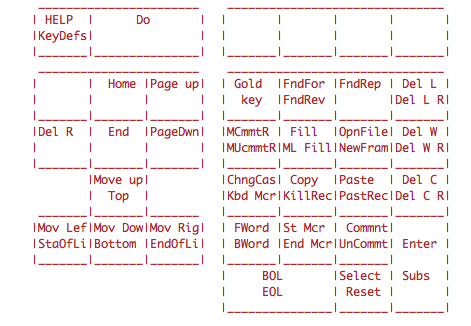I learned to program on a CDC-1604, then a CDC-6400 (but those were punched cards), then a TI-990 (no memories of that editor).
Then at my first real job, there was a PDP-11/34 which later turned into a VAX-11/780. So I learned to hack in EDT, followed by TPU, and they are deep in my muscle memory. Enough so that when the VAX, then the Apollo, then NeXT, then the IBM RISC mini, got Emacs, I wrote a set of scripts that emulated the EDT numeric keypad functions on VT-101 keyboard. No, I don’t want the tpu-edt.el emulation – I want crunchy Emacs control-meta goodness; I just want it with the EDT keypad macros that my right hand knows and loves. And the left hand pinkie control-RSI that I hate.
These, then, followed me around for years, and many OSes.
At some point, I counted the number of different text editors I had had to learn (the number was in the dozens), all different, and I decided – that’s it. No more native editors. I’m going to use Emacs. Forever. On any system. On every system. Emacs and TeX. Emacs, LaTeX, and an HP-48 RPN. An early fuddy-duddy, I think I might have been 27 when I decided this. But, hey, in the nascent computer world, after 20 some-odd different editors, and 20 some-odd different sets of key combos….
Of course, businesses live and die by Word, and Powerpoint, and Excel, so I haven’t avoided those. Though if I can, I do. And there have been a few other editors. Matlab, for instance, in which I spend a good deal of my waking hours, broke the Emacslink connection long ago, so there’s no escaping their native shitty editor. Dammit. (So there are a couple of keys on that keypad that are available to be reassigned.) I have fond memories of using XEDIT and REXX on the IBM mainframe at Princeton (sigh, split screens in the same file, and rational text processing). BBedit isn’t bad. If I want to find the error in LaTeX, I still have to fire up TeXShop, though I refuse to write in it. If an editor doesn’t have a rectangular copy and paste (^xrk, ^xry), it’s never going to be my favorite.
But the worst part was that the EDT scripts I wrote for Emacs have been broken on Macs for years, because OS X didn’t distinguish between the keypad and the number keys. There was no way to tell Emacs on OS X to execute an Emacs macro when you hit the keypad – without losing all the number keys. And that just ain’t workable. Emacs on Windows sucks, as does most everything else, and having still used Linux on laptops for the last few years (Xylinx doesn’t make an FPGA compiler for OS X), the Linux desktop is still maddening. I’d rather use the editors on a Mac laptop than Emacs on Linux desktop, so Emacs got relegated to writing publications. Not unused, but daily editing was in the Mac system. At least OS X enforces a consistent set of key-combo functionalities.
However, sometime between Emacs 23 and Emacs 24, this functionality was restored (sadly, it looks like in 2014 but that seems like about the last time I tried to make it work, so I missed it.). Today, I found out about it. I am one happy geek, now that the muscle memory I developed at age 22 on a PDP-11 can come into play again!
Maybe I’ll look into SciPy again, if I can use Emacs and Matlab won’t let me… Ha! Not really, I still have to work with other people.
I am, however, writing the GSE user manual in LaTex and Emacs, and screw NASA. Still far superior to Word in every way except Track Changes.
And PCalc does a pretty fair job of emulating an HP-48 on my desktop, and iPhone, though the scripts that my original 48 had programmed in are long gone…
